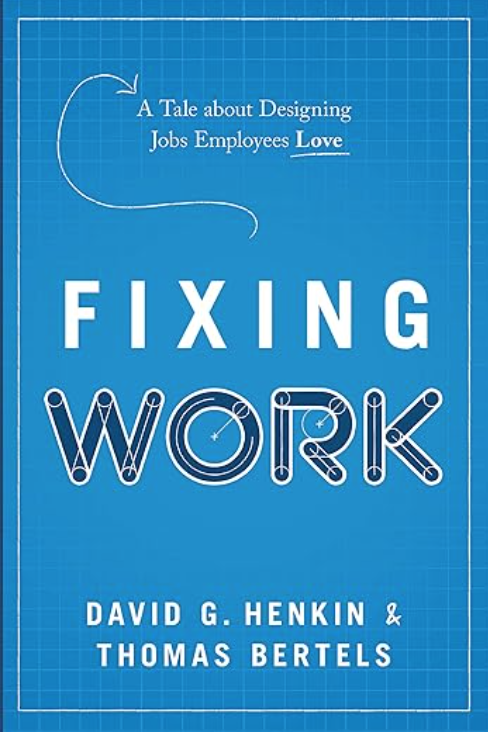The Overlooked Art and Science of Job Design
 Two experts on how to design more meaningful jobs at any level of the organization share their expertise on an Enterprise Engagement Alliance YouTube Show: The Overlooked Art and Science of Job Design.
Two experts on how to design more meaningful jobs at any level of the organization share their expertise on an Enterprise Engagement Alliance YouTube Show: The Overlooked Art and Science of Job Design.Business and social media are filled with articles about employee engagement and experience: much less attention is given to the concept of job design: How to design purpose, goals, objectives into a job and organize tasks to make people as productive and as satisfied as possible.
Click here to view the show on Youtube. You can also listen to it on the EEA Stakeholder Capitalism podcast series.
Rather than focusing on the traditional topics related to employee engagement and experience—leadership, communication, rewards and recognition, DEI (diversity, equity, inclusion)—job design focuses specifically on what people do every day in a way on their jobs that makes them happier to do the work and therefore more productive.
 The expert panelists are Thomas Bertels, Founder and Principle of Purpose Works Consulting LLC, and Ellen G. Frank-Miller, PhD, Founder and CEO of WORC (Workforce & Organizational Research Center). Both are pioneers in the area of job design.
The expert panelists are Thomas Bertels, Founder and Principle of Purpose Works Consulting LLC, and Ellen G. Frank-Miller, PhD, Founder and CEO of WORC (Workforce & Organizational Research Center). Both are pioneers in the area of job design.Bertel’s new book Fixing Work—“A Tale About Designing Jobs Employees Love”—was just published. It tells the story of an organization’s path to a more effective way to design more desirable jobs. The book, based on his years of experience in job design, uses a narrative approach to flesh out his key points about how to make jobs more desirable.
Frank-Miller’s organization, in partnership with the National Fund for Workforce Solutions, and supported by a grant from the Bill and Melinda Gates Foundation, last year created job quality outcome maps. The free evidence-backed Job Quality Maps, she explains, “empower employers to solve pressing business problems by selecting job characteristics as targets for improvement to shift human capital management KPIs (e.g., engagement, turnover intention, burnout) for business impact.”
 Here is a summary of some of the key insights from the EEA YouTube program:
Here is a summary of some of the key insights from the EEA YouTube program:- Effective job design starts with addressing basic material needs. One cannot expect anyone at any level to work at their best if they are struggling to put food on the table.
- Job design experts help organizations not only develop effective jobs that foster retention, productivity, and quality but to create a culture based on purpose, autonomy, and a sense of ownership. It remains a largely unknown field in part because it is barely taught in schools. Zeynop Ton, an MIT professor, is credited with helping to raise awareness about job design through the creation of the Good Jobs Institute and her books The Good Jobs Strategy and The Case for Good Jobs.
- Job design goes beyond rewards, recognition, or employee experience to determine the actual purpose, goals, and objectives of a job within the context of its external or internal customers and the organizational mission and vision.
- The benefits of effective job design are higher retention, quality, productivity, willingness to refer, safety, and wellness, to name a few.
- Employee voice is critical to job design, because the process should always be considered a work in progress that can be continually improved. Regularly scheduled check-ins with each employee can make a significant difference in employee engagement by detecting issues that otherwise might go unnoticed in surveys.
- Artificial intelligence (AI) should be viewed as a tool to improve tasks, not as a means of eliminating jobs. As with any other job design process, the more employees are involved in utilizing AI as a tool, the better.
- Companies that take a blanket approach to work from home likely will lose the people with the most talent, as they have the best chance of finding another job. The work-from-home phenomenon is an opportunity to take a fresh look at job design and to actively involve employees in the process of developing policies to maximize buy-in. Each job group and team have different reasons to work alone or together in groups.
- Having meaningful metrics for job performance is critical to creating a sense of meaning, but only if the employee has control over the outcome of the metrics.
- What is the maturity level of the typical US company when it comes to having a strategic and systematic approach to job design? Ellen Frank-Miller was hesitant to provide a rating other than to say there is room for improvement. Thomas Bertels rated the average company a five on a scale of 10, adding that he has seen an increase in interest in job design over the last few years as CEOs have increasingly reckoned with employee turnover.
Ellen Frank-Miller, Founder, CEO
WORC at https://www.workresearchcenter.org
ellen@worcimpact.com
Thomas Bertels, Founder and President
https://www.purpose.works
thomas.bertels@purpose.works
Bruce Bolger, Founder
Enterprise Engagement Alliance at https:/TheEEA.org
Bolger@TheEEA.org
ESM Is Published by The EEA: Your Source for Effective Stakeholder Management, Engagement, and Reporting
Through education, media, business development, advisory services, and outreach, the Enterprise Engagement Alliance supports professionals, educators, organizations, asset managers, investors, and engagement solution providers seeking a competitive advantage by profiting from a strategic and systematic approach to stakeholder engagement across the enterprise. Click here for details on all EEA and ESM media services.
1. Professional Education on Stakeholder Management and Total Rewards
- Become part of the EEA as an individual, corporation, or solution provider to gain access to valuable learning, thought leadership, and marketing resources to master stakeholder management and reporting.
- The only education and certification program focusing on Stakeholder Engagement and Human Capital metrics and reporting, featuring nine members-only training videos that provide preparation for certification in Enterprise Engagement.
- EEA books: Paid EEA participants receive Enterprise Engagement for CEOs: The Little Blue Book for People-Centric Capitalists, a quick implementation guide for CEOs; Enterprise Engagement: The Roadmap 5th Edition implementation guide; a comprehensive textbook for practitioners, academics, and students, plus four books on theory and implementation from leaders in Stakeholder Management, Finance, Human Capital Management, and Culture.
2. Media
- ESM at EnterpriseEngagement.org, EEXAdvisors.com marketplace, ESM e–newsletters, and library.
- RRN at RewardsRecognitionNetwork.com; BrandMediaCoalition.com marketplace, RRN e-newsletters, and library.
- EEA YouTube Channel with over three dozen how-to and insight videos and growing with nearly 100 expert guests.
3. Fully Integrated Business Development for Engagement and Total Rewards
Strategic Business Development for Stakeholder Management and Total Rewards solution providers, including Integrated blog, social media, and e-newsletter campaigns managed by content marketing experts.
4. Advisory Services for Organizations
Stakeholder Management Business Plans; Human Capital Management, Metrics, and Corporate Sustainability Reporting for organizations, including ISO human capital certifications, and services for solution providers.
5. Outreach in the US and Around the World on Stakeholder Management and Total Rewards
The EEA promotes a strategic approach to people management and total rewards through its e-newsletters, web sites, and social media reaching 20,000 professionals a month and through other activities, such as:
- Association of National Advertisers Brand Engagement 360 Knowledge Center to educate brands and agencies.














